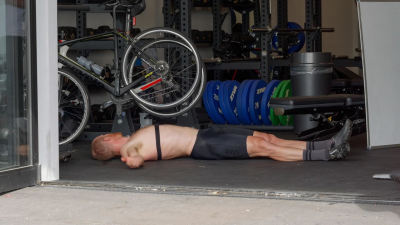FTP is an acronym that first caught my attention during its rapid rise to fame within my social and training circles in 2016. As a passionate student of endurance sport, I was aware of lactate threshold, anaerobic threshold and even ventilatory threshold. Though I couldn’t confidently state a clear definition that separated one from the other.
With time I was able to make better sense of FTP - or Functional Threshold Power to use its full name (like mum used to do with me when I was caught playing PlayStation after not cleaning my room as promised)...
What is FTP?
FTP basically describes the highest average power you can sustain for about an hour. So, it's the power you can push when you're motivated to dig deep whilst keeping the effort evenly paced - Perhaps if you're being chased by a scary dog that's travelling about a metre behind your back wheel for 60 minutes.
Two popular and practical ways to test your FTP are:
- A 20-minute time trial where the name of the game is pacing it evenly and near-maximal effort towards the end
- Or via a ramp test like those offered on indoor cycling platforms such as Zwift
Both options take a calculation on the end result to predict FTP without the need to release the aforementioned scary dog from its cage to chase after you for an hour.
Why is FTP useful?
Once we have an estimation of FTP, we can use it to set the all-important training zones.
This can help us work the right energy systems for the desired outcome of each training session. It will also place a line in the sand where you can re-test and reference FTP shifts over time (through those sessions being performed in appropriate training zones as described).
The other application can be to help plan and execute a race day pacing strategy, such as when I raced Challenge Roth whilst targeting 80% of my FTP in 2017. Fundamentally, measuring and tracking FTP helps keep us accountable to the training and race day process.
Having a higher FTP essentially means we can cycle harder and faster for the same effort. I often say to my coached athletes that increasing FTP is like ‘lifting the ceiling’ at the point when we begin to burn matches on the bike.

How to improve your FTP
This is what we all really want to know. How do we boost our FTP to levels that catch attention during bunch ride conversations?
The first thing I would say is that FTP is relative to body weight which is what we refer to as power-to-weight ratio.
So, if a 100kg athlete has an FTP of 300 watts, they have a relative FTP of 3 watts per kilo (300/100 = 3).
If a 60kg person only has an FTP of 260w, they actually have a higher relative FTP of 4.3w/kg, which in the cycling world will usually win more races, especially the ones with elevation gain!
So, to improve relative FTP you can target two things: weight loss and/or FTP gain. I will focus on FTP gain here, as weight loss is a whole other topic that's best explained by a qualified dietician.
One of the ‘low hanging fruits’ for FTP improvement might surprise some as it's aerobic volume. This generally involves riding at 55-75% of FTP (Zone 2) for increasingly longer periods of time across weeks and months. The changes that happen physiologically will improve your FTP (a big topic that you can read more about via many online articles on Zone 2 training for FTP improvement).
I want to focus on two types of interval session that become a staple during my Emirates Team NZ training program while I was preparing by body to produce maximal watts as a cyclor in 25-30 minute races during the 2024 America’s Cup:
1. The classic ‘threshold’ session:
- 20-30 minute warm up, finishing with 3x 1 minute @ approximate FTP power / 1 minute recoveries
- 5 minute easy spin
- 5 x 5 minute @ FTP power or better with 2.5 minutes easy spin between each (always trying to perform the first 5 minute interval at a level of effort that you can then build from in each subsequent 5 minute interval. Ideally doing your highest 5 minute average on the fifth and final repeat)
- 10-20 minutes easy spin to flush the legs
- Total session time: 1.20-1.30 hours
This session was always one I knew I needed to precede with an easier training day, so I had a little bit of freshness in the legs ahead of it. I also knew I needed to bring some focus and a willingness to suffer a bit for the greater cause, so would often give myself a motivational pep talk ahead of starting.
How I fueled this session: I knew I would perform best in this session if I took a PF 30 Caffeine Gel during the warm up, so it was making its way into my blood stream as the main set rolled around. I would also use the PH Carb & Electrolyte Drink Mix during the main set, to ensure the fuel tank remained topped up.
2. The Vo₂ max session:
- 20-30 minute warm up, finishing with 3x 1 minute @ building intensity: 100 / 110 / 120% FTP with 1 minute easy between each
- 5 minute easy spin
- 20x 1 minute hard, 1 minute easy: targeting an overall average of 120-130% of FTP by the end. Again, ideally you would build through each set of 5x 1 minute blocks. So the first 5x 1 minutes are the lowest overall average and the final 5x 1 minutes are at the highest overall average across the 20 repeats
- 10-20 minute very easy spinning to flush the legs
- Total session time: 1.30-1.40 hours
The “20 by 1 minute” session was arguably the most intimidating training session of the entire training schedule. There's something tremendously empowering, both physically and mentally, about superseding FTP power in an interval session. This provokes a ‘super compensation’ effect that psychologically and physically helps your current FTP begin to feel less taxing over time (signifying an improvement in predicted FTP).
How I fueled this session: Once again I knew this was a session that demanded respect. I would have an easier training day the day prior, have a small carbohydrate rich breakfast such as oats with banana about an hour beforehand, then a PF 30 Caffeine Gel during the warm up.
I’d have a quiet word to myself before beginning the session so I was fired up and ready to hurt when I needed to. Also, just like the 5 x 5 minute session, I would sip on PH Carb & Electrolyte Drink Mix during the 1 minute recoveries to help fuel me through the main set.
Do try this at home
The classic threshold session and Vo₂ max sessions described above would feature once or twice each fortnight (i.e. sometimes just one or the other in a week, sometimes, but rarely both in the same week).
They would be supplemented with plenty of the critical zone 2 “aerobic” riding volume and would virtually guarantee an upwards trajectory in FTP by the time we’d retest it at the end of a key 10 to 12 week training block.
The beauty of FTP is that it relates specifically to you and nobody else. So, to work at 100% of FTP for 5 minute blocks or 120% of FTP for 20x 1 minute blocks will hurt the 55-year-old businessman who's training 6 hours per week as much as the 25-year-old professional athlete training 20 hours per week.
Testing and recording your FTP (via one of the methods described above) is a great first step to establish your training zones and draw a line in the sand.
As a next step, try packing in some aerobic riding for approximately 80% of your total riding time each week. With the other 20% of time on the bike, why not give one or both of my “FTP staples" a crack for 8-12 weeks and see where life takes you?
If you can do at least one of these sessions each week, I can almost guarantee you’ll see a positive shift in that trendy FTP number...
